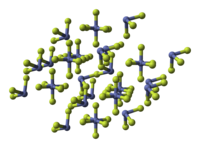Cobalt trifluoride
 |
|
| Names | |
|---|---|
| Other names
Cobalt trifluoride
Cobaltic fluoride Cobalt fluoride Cobaltic trifluoride |
|
| Identifiers | |
|
3D model (Jmol)
|
|
| ChemSpider | |
| ECHA InfoCard | 100.030.045 |
| EC Number | 233-062-4 |
|
PubChem CID
|
|
| UNII | |
|
|
|
|
| Properties | |
| CoF3 | |
| Molar mass | 115.928 g/mol |
| Appearance | brown powder |
| Density | 3.88 g/cm3 |
| Melting point | 927 °C (1,701 °F; 1,200 K) |
| reacts | |
| +1900.0·10−6 cm3/mol | |
| Structure | |
| hexagonal | |
| Hazards | |
| NFPA 704 | |
| Related compounds | |
|
Other anions
|
cobalt(III) oxide, cobalt(III) chloride |
|
Other cations
|
iron(III) fluoride, rhodium(III) fluoride |
|
Related compounds
|
cobalt(II) fluoride |
|
Except where otherwise noted, data are given for materials in their standard state (at 25 °C [77 °F], 100 kPa).
|
|
|
|
|
| Infobox references | |
Cobalt(III) fluoride is the inorganic compound with the formula CoF3. This highly reactive, hygroscopic brown solid is used to synthesize organofluorine compounds. CoF3 is a powerful fluorinating agent that leaves CoF2 as the byproduct.
CoF3 is prepared in the laboratory by treating CoCl2 with fluorine at 250 °C:
This conversion is a redox reaction: Co2+ and Cl− are oxidized to Co3+ and Cl2, respectively, while F2 is reduced to F−. Cobalt(II) oxide (CoO) and cobalt(II) fluoride (CoF2) can also be converted to cobalt(III) fluoride using fluorine.
CoF3 decomposes upon contact with water to give oxygen:
CoF3 is hygroscopic, forming a dihydrate (CAS#54496-71-8). It reacts with fluoride sources to give the anion [CoF6]3−, which is a rare example of a high-spin, octahedral cobalt(III) complex.
Used as slurry, CoF3 converts hydrocarbons to the perfluorocarbons:
Such reactions are sometimes accompanied by rearrangements or other reactions. The related reagent KCoF4 is more selective.
...
Wikipedia

